SQL to JSON Data Modeling with Hackolade
Review: SQL to JSON data modeling
First, let’s review, the main way to represent relations in a relational database is via a key/foreign key relationship between tables.
When looking at modeling in JSON, there are two main ways to represent relationships:
Referential - Concepts are given their own documents, but reference other document(s) using document keys.
Denormalization - Instead of splitting data between documents using keys, group the concepts into a single document.
I started with a relational model of shopping carts and social media users.
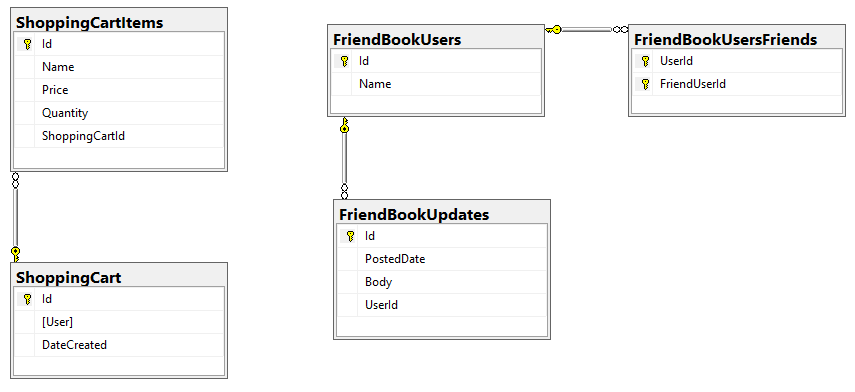
In my example, I said that a Shopping Cart - to - Shopping Cart Items relationship in a relational database would probably be better represented in JSON by a single Shopping Cart document (which contains Items). This is the "denormalization" path. Then, I suggested that a Social Media User - to - Social Media User Update relationship would be best represented in JSON with a referential relationship: updates live in their own documents, separate from the user.
This was an entirely manual process. For that simple example, it was not difficult. But with larger models, it would be helpful to have some tooling to assist in the SQL to JSON data modeling. It won’t be completely automatic: there’s still some art to it, but the tooling can do a lot of the work for us.
Starting with a SQL Server DDL
This next part assumes you’ve already run the SQL scripts to create the 5 tables: ShoppingCartItems, ShoppingCart, FriendBookUsers, FriendBookUpdates, and FriendBookUsersFriends. (Feel free to try this on your own databases, of course).
The first step is to create a DDL script of your schema. You can do this with SQL Server Management Studio.
First, right click on the database you want. Then, go to "Tasks" then "Generate Scripts". Next, you will see a wizard. You can pretty much just click "Next" on each step, but if you’ve never done this before you may want to read the instructions of each step so you understand what’s going on.
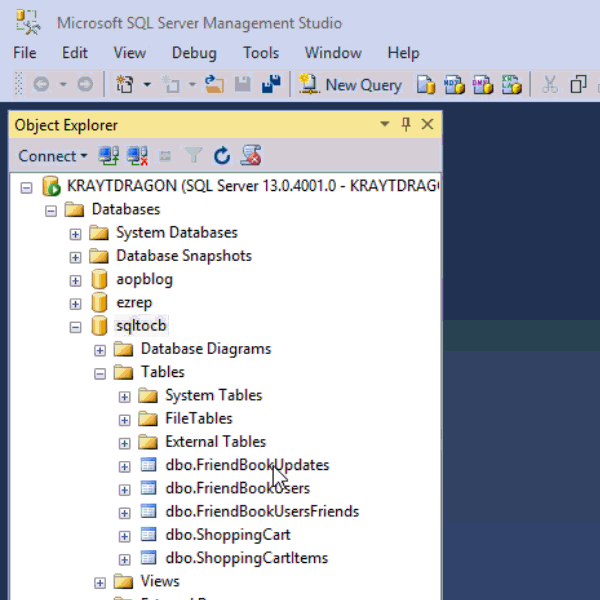
Finally, you will have a SQL file generated at the path you specified.
This will be a text file with a series of CREATE and ALTER statements in it (at least). Here’s a brief excerpt of what I created (you can find the full version on Github).
CREATE TABLE [dbo].[FriendBookUpdates](
[Id] [uniqueidentifier] NOT NULL,
[PostedDate] [datetime] NOT NULL,
[Body] [nvarchar](256) NOT NULL,
[UserId] [uniqueidentifier] NOT NULL,
CONSTRAINT [PK_FriendBookUpdates] PRIMARY KEY CLUSTERED
(
[Id] ASC
)WITH (PAD_INDEX = OFF, STATISTICS_NORECOMPUTE = OFF, IGNORE_DUP_KEY = OFF, ALLOW_ROW_LOCKS = ON, ALLOW_PAGE_LOCKS = ON) ON [PRIMARY]
) ON [PRIMARY]
GO
-- etc...By the way, this should also work with SQL Azure databases.
Note: Hackolade works with other types of DDLs too, not just SQL Server, but also Oracle and MySQL.
Enter Hackolade
This next part assumes that you have downloaded and installed Hackolade. This feature is only available on the Professional edition of Hackolade, but there is a 30-day free trial available.
Once you have a DDL file created, you can open Hackolade.
In Hackolade, you will be creating/editing models that correspond to JSON models: Couchbase (of course) as well as DynamoDB and MongoDB. For this example, I’m going to create a new Couchbase model.
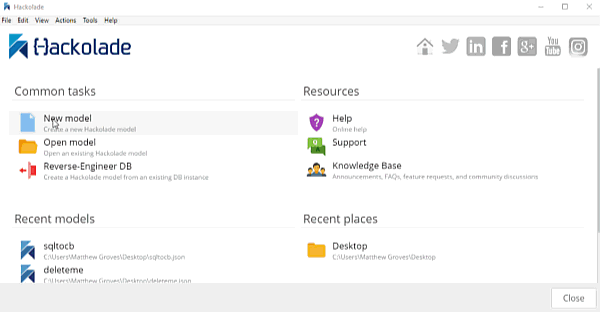
At this point, you have a brand new model that contains a "New Bucket". You can use Hackolade as a designing tool to visually represent the kinds of documents you are going to put in the bucket, the relationships to other documents, and so on.
We already have a relational model and a SQL Server DDL file, so let’s see what Hackolade can do with it.
Reverse engineer SQL to JSON data modeling
In Hackolade, go to Tools → Reverse Engineer → Data Definition Language file. You will be prompted to select a database type and a DDL file location. I’ll select "MS SQL Server" and the "script.sql" file from earlier. Finally, I’ll hit "Ok" to let Hackolade do its magic.

Hackolade will process the 5 tables into 5 different kinds of documents. So, what you end up with is very much like a literal translation.
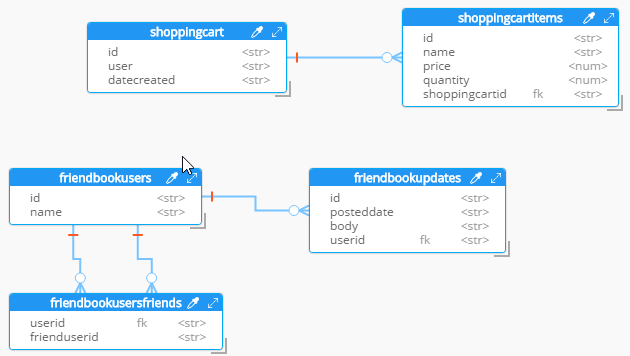
This diagram gives you a view of your model. But now you can think of it as a canvas to construct your ultimate JSON model. Hackolade gives you some tools to help.
Denormalization
For instance, Hackolade can make suggestions about denormalization when doing SQL to JSON data modeling. Go to Tools→Suggest denormalization. You’ll see a list of document kinds in "Table selection". Try selecting "shoppingcart" and "shoppingcartitems". Then, in the "Parameters" section, choose "Array in parent".
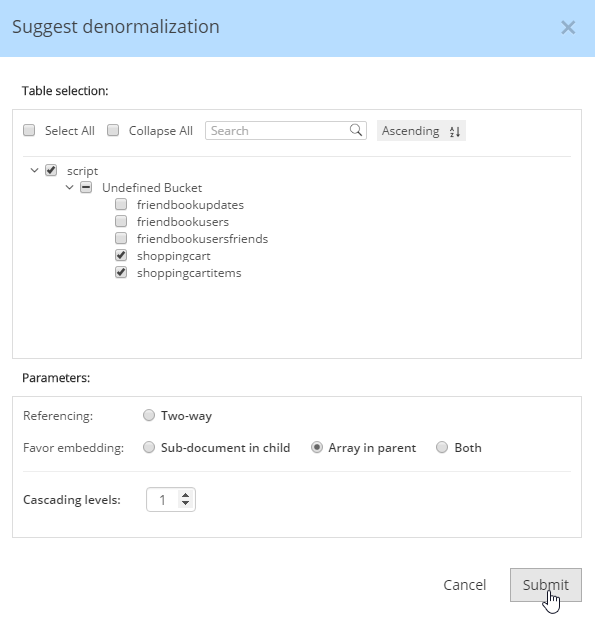
After you do this, you will see that the diagram looks different. Now, the items are embedded into an array in shoppingcart, and there are dashed lines going to shoppingcartitems. At this point, we can remove shoppingcartitems from the model (in some cases you may want to leave it, that’s why Hackolade doesn’t remove it automatically when doing SQL to JSON data modeling).
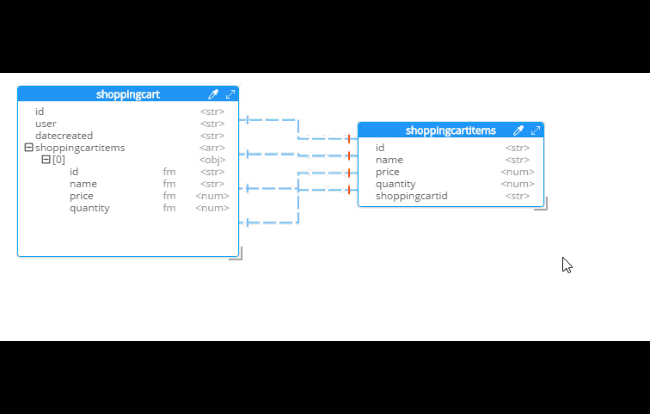
Notice that there are other options here too:
Embedding Array in parent - This is what was demonstrated above.
Embedding Sub-document in child - If you want to model the opposite way (e.g. store the shopping cart within the shopping cart item).
Embedding Both - Both array in parent and sub-document approach.
Two-way referencing - Represent a many-to-many relationship. In relational tables, this is typically done with a "junction table" or "mapping table"
Also note cascading. This is to prevent circular referencing where there can be a parent, child, grandchild, and so on. You select how far you want to cascade.
More cleanup
There are a couple of other things that I can do to clean up this model.
Add a 'type' field. In Couchbase, we might need to distinguish shoppingcart documents from other documents. One way to do this is to add a "discriminator" field, usually called 'type' (but you can call it whatever you like). I can give it a "default" value in Hackolade of "shoppingcart".
Remove the 'id' field from the embedded array. The SQL table needed this field for a foreign key relationship. Since it’s all embedded into a single document, we no longer need this field.
Change the array name to 'items'. Again, since a shopping cart is now consolidated into a single document, we don’t need to call it 'shoppingcartitems'. Just 'items' will do fine.
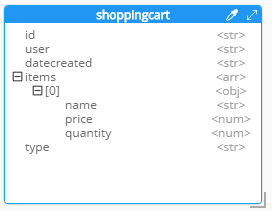
Output
A model like this can be a living document that your team works on. Hackolade models are themselves stored as JSON documents. You can share with team members, check them into source control, and so on.
You can also use Hackolade to generate static documentation about the model. This documentation can then be used to guide the development and architecture of your application.
Go to File → Generate Documentation → HTML/PDF. You can choose what components to include in your documentation.
SQL to JSON Data Modeling with Hackolade的更多相关文章
- MS SQL OPENJSON JSON
前段时间,有写过一个小练习<MS SQL读取JSON数据>https://www.cnblogs.com/insus/p/10911739.html 晚上为一个网友的问题,尝试获取较深层节 ...
- directly receive json data from javascript in mvc
if you send json data to mvc,how can you receive them and parse them more simply? you can do it like ...
- Guzzle Unable to parse JSON data: JSON_ERROR_SYNTAX - Syntax error, malformed JSON
项目更新到正式平台时,出现Guzzle(5.3) client get请求出现:Unable to parse JSON data: JSON_ERROR_SYNTAX - Syntax error, ...
- sql System.Data.SqlClient.SqlError: 无法覆盖文件 'C:\Program Files\Microsoft SQL Server\MSSQL\data\itsm_Data.MDF'。数据库 'my1' 正在使用该文件的解决方案
对数据库备份进行还原时遇到“sql System.Data.SqlClient.SqlError: 无法覆盖文件 'C:\Program Files\Microsoft SQL Server\MSSQ ...
- SQL*Net more data to client
The server process is sending more data/messages to the client. The previous operation to the client ...
- SQL*Net more data from client
SQL*Net more data from client The server is waiting on the client to send more data to its client sh ...
- 奇葩的SQL*Net more data from client等待,导致批处理巨慢
<pre name="code" class="sql"><pre name="code" class="sql ...
- 一个session已经ACTIVE20多小时,等待事件SQL*Net more data from client
问题描述: 一个session已经ACTIVE20多小时,等待事件SQL*Net more data from client 有一人session,从昨天上午11点多登陆(v$session.logi ...
- iReport 5.6.0 Error: net.sf.jasperreports.engine.JRException: Error executing SQL statement for : data 最优解决方案
问题描述 近期学习iReport(个人使用的是最新版本的 iReport-5.6.0,MySQL是 5.5.56版本),遇到一些问题,在安装完成后,创建了数据库,配置了MySQL数据库连接信息,新建报 ...
随机推荐
- 支持“xxxContext”上下文的模型已在数据库创建后发生更改。请考虑使用 Code First 迁移更新数据库
将项目的数据库连接用户及密码修改后(切换用户,用户名与原来不一样,用户下对象结构一致),报以下错误: 支持“XXXDBContext”上下文的模型已在数据库创建后发生更改.请考虑使用 Code Fir ...
- SpringBoot集成Shiro安全框架
跟着我的步骤:先运行起来再说 Spring集成Shiro的GitHub:https://github.com/yueshutong/shiro-imooc 一:导包 <!-- Shiro安全框架 ...
- i++ 相比 ++i 哪个更高效?为什么?
++i的效率高些,++i在运算过程中不产生临时对象,返回的就是i,是个左值,类似++i=1这样的表达式是合法的,而i++在运算的过程中会产生临时对象,返回的是零时对象的值,是个右值,像i++=1这样的 ...
- 周末时间学习Linux
大家都是如何度过周末时光的呢?好多人都认为一周的工作后要好好休息下,于是在家疯狂的补觉,刷剧,打游戏,自我觉得很是正常,工作几天了,休息下不是当然嘛.是的,休息下很正常,但是把周末的时光都用到这些东西 ...
- Volterra方程的不动点
- pdf中内嵌字体问题
在提交论文pdf到IEEE时总要检查字体是否为内嵌的,查看pdf中所有字体及是否内嵌可查看:http://sinme.blog.sohu.com/120043575.html. 具体做法是: 在pdf ...
- scrapy之五大核心组件
scrapy之五大核心组件 scrapy一共有五大核心组件,分别为引擎.下载器.调度器.spider(爬虫文件).管道. 爬虫文件的作用: a. 解析数据 b. 发请求 调度器: a. 队列 队列是一 ...
- python_超级基础
初识计算机 CPU 计算机的大脑.中央处理单元,主要负责数据运算及计算,是运算计算中心. 存储器 内存 临时存储数据,供CPU运算使用. 优点: 读取速度快. 缺点: 容量小,成本高,断电即消失. 硬 ...
- Redis使用和部分源码剖析以及Django缓存和redis的关系
0.特点: a.持久化 b.单进程.单线程 c.5大数据类型 d.用于操作内存的软件. e.虽然是缓存数据库但是可以做持久化的工作 MySQL是一个软件,帮助开发者对一台机器的硬盘进行操作 ...
- 福州大学软件工程1816 | W班 第1次作业成绩排名
1.作业地址 第一次作业--准备篇 2.作业要求 (1)回想一下你初入大学时对计算机专业的畅想 当初你是如何做出选择计算机专业的决定的? 你认为过去两年中接触到的课程是否符合你对计算机专业的期待,为什 ...
